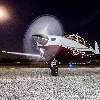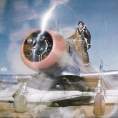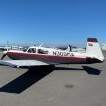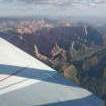Search the Community
Showing results for 'insulation'.
-
Planning to update my interior. Fortunately the plastic is in pretty good shape, only requiring a small amount of repair before repaint. I don't know what if any insulation was replaced when SB M20 208 tube inspection was done, so looking for recommendations for insulation. Probably more interested in thermal and weight saving vice chasing soundproofing. The stuff on AC Spruce looks to be chop foam like carpet underlayment with aluminum foil and is NOT approved for certified aircraft. Also, the interior headliner is pretty stained and looks like it should be easy to replace. The current material looks to be a thin vinyl (over foam?) and would be fine in a different color. ACSpruce sells wool with a burn cert, but I'm not sure I want to go that route. Some of the refurbished aircraft on my home field have some woven fabrics that look nice too. Recommendations and discussion appreciated. Thanks!
-
Do you have a cite to support your belief? It doesn't pass the sniff test: If no gas flow is required after 'the purge' then why do I see the tanks remain in place PERMANENTLY. And, why do the cables need to be 'dried out' in the first place? It seems far more likely that all the connections within the BOXES are prone to corrosion, NOT wires with all manner of insulation inherent in their construction. Without out some form of verifiable proof one way or the other we are just another pair of SGOTIs disagreeing
-

New Paint any noticeable airspeed increase, weight saving?
KSMooniac replied to Brian2034's topic in General Mooney Talk
We re-weighed my plane last month after some extensive mods to include a full paint job (final step in my hail repair/upgrade sequence). I gained ~80 lbs over the book numbers, and at least half of that is the paint job IMO. I think today's paint with "friendlier" chemical compositions and higher amounts of solids are quite a bit heavier than what was applied in the early days and likely through the 80's. Doing metallics or other systems with base + clear coat make it even worse, too. The rest of my weight gain can be attributed to the later overhead vent system, SoundEx insulation, and a full set of Bravo seats (2x articulating fronts, removable buckets in back) with memory foam inside and headrests. -
Maybe. But cables in the ground are contiguous and covered with insulation. The equipment in the boxes have many CONNECTIONS that would be susceptible to corrosion, I would think. But I admit to speculation
-
I went with Mac's as they were a lot cheaper. And I was looking mainly for insulation hold in heat from the oil pan heater. I did not call or email, it was just strange that I placed the order and wasn't even sure it had gone through until the cover showed up. Not a big deal, just a data point.
-
I did everything but the headliner in my plane years ago. I used the pre cut insulation kit. Now wish I had done the headliner; it's sagging in a few area. If you could find some compliance self stick material, I can't imagine it being that difficult. If you've gotta spray glue, seems like it could be messy.
-
Thanks Fritz1. I was looking for insulation, and Spruce calls it soundproofing. Here's the link for the pre-cut kits (approx. $1000). https://www.aircraftspruce.com/catalog/appages/soundex.php Individual Soundex sheets are cheaper, but not cheap. Has anybody used this 3M material? https://www.aircraftspruce.com/catalog/appages/dampingpanels.php 18" x 48" is $200.
-
Spruce sells the sound ex material in different thickness, approved for cert aircraft, maybe go for the thinnest one to save weight, there are pre-cut sets for many aircraft types, buying by the roll is typically less expensive, make card board templates first and then cut insulation material with heavy pair of scissors
-
Has anybody that has a surefly electronic ignition flown it in the flight levels? I just got off the phone with Maggie harnesses and their tech guy warned me that surefly has been having arcing problems at altitude because even though the Sim will not arc like a an unpressurized mag will they have seen arcing in the cap where the leads are and thus need to pressurize the cap to keep that from happening. I talked to jim Baker that doesn’t do mooneys but does do cirruses and he confimed that you have to get better insulation in the cap or pressurize it where the lead wires enter or you will get arcing in the flight levels. So anybody with a surefly installed, have you tested it up in the flight levels yet? Have you modified the cap to keep this from happening?
-
Anxious and Empathetic - Hurricane Milton
Grant_Waite replied to mmcdaniel33's topic in Modern Mooney Discussion
It’s astounding the level of effort some put into being a CB. We lost power 4 hours into it Thursday and ran on the whole house generator almost nonstop until Monday. We started at 67%, on a 500gal tank. We ran it down into the high 30s before the propane guy came Sunday to refill the tank. Thank God, because we weren’t expecting anyone to show up. Cost 900 something to fill it back up and we got power back early Monday. We could have gone without power for a whole month after he filled it. Our entire house ran 3 ac’s, two 5 tons another smaller one and mini split, 2 full size refrigerators, 3 wine fridge’s, well, hot water heater, and everything else. Our house turned into a refuge camp for those CB that didn’t have one. We had an extension cord and hose running to the next door neighbor basically the whole time. Needless to say a whole house generator is 1000% worth the investment in hurricane prone states… no question about it. Our house was built in 2019 and has spray foam insulation in the whole roof, so it doesn’t leak air at all. All the leds and everything else helps a lot too. Idk about some but sleeping without AC is truly miserable and a major first world problem. -
@kortopates I sent an email to Surefly and their response was a recommendation to pressurize cap... FWIW I've not been aware of any issues at altitude and have flown routinely in the high teens and low FL's since having the Surefly installed in April 2023. Sounds like Jim Barker is a Cirrus mechanic and they were running into some issues with Surefly in turbo Cirrus applications flown routinely in the FLs. hmmm. "Hello Marc, we have found that when an aircraft is operated at higher altitudes with standard harnesses arcing in the cap can occur due to separation in the wire insulation of the leads at those lower atmospheric pressures. We have since been recommending either a high altitude harness or a pressurized cap or both. A high altitude harness can be manufactured for you by Alan Woods at Champion Aerospace. His e-mail is alanwoods@champaero.com 864-843-7801. And a pressurizing kit can be acquired from Jim Barker of Aviation Resources. His contact info is jim@aviationvibes.com 715-822-5787."
-
What can cause a magnetized cage in the Ovation?
1980Mooney replied to Ed de C.'s topic in Modern Mooney Discussion
Been discussed before. Everyone in old topic below says an AC cord cannot magnetize anything because it keeps alternating and reversing fields. DC power cords will magnetize the steel frame. Your 28v wires either zip tied across or along the tubing are more likely to cause magnetism. In 25 years of the same plane, I have had corded vacuums, lights, power tools in the cabin - sometimes for long periods like while replacing cabin insulation. One especially humid Gulf Coast winter in a crap hanger without sealed concrete I had a low wattage incandescent light with a small fan running continuously in the cabin for a while. Never a problem. As @Hank says, a canister on the wing with a hose may work better given the limited space. Also the motor heat blowing into the cabin is unbearable most times. I generally also just set on the wing. -
Most of my neighbors have insulated hangers and eventually i will just foam my hanger then put a mini split a/c a 24,000btu system can be had for $1,400 and will cool 1250sf you dont need it to cool down alot. Just 10 degrees difference will lower the humidity in the hanger to keep corrosion at bay. Figure $4000 for foam insulation (don’t need think just enough to seal off all the drafts so $5,500 you could keep corrosion and critters out of your plane, in the grand scheme of expenses not much for whole aircraft protection.
-
Aside from a tight door seal, are there any real ways to reduce the decibel level in the Mooney? The only complaint I have with the plane is the noise. I don’t know that any other single is that much better. I mean the reality is that we are sitting on a big no power engine with nothing more than a thin aluminum body with pretty thin insulation, so it is a challenge. I would think thicker glass and denser insulation would make a difference, but not sure if it would make an attributable difference. And yes, I know about ANR headsets, but I have a problem with my ears that they only make worse. I would gladly give up 20 or 30# of UL to make it measurably quieter. Has anyone successfully done this? If so, how and what was the decibel reduction?
-

Are there any true effective ways to reduce the noise of a Mooney?
GeeBee replied to Schllc's topic in General Mooney Talk
When I was having my interior redone, I thought about re-doing the sound insulation then I thought, "No matter how much and how good you use, you're still going to wear an ANR headset anyway". So I kept the stock insulation because it is a losing battle in a recap. There is only one airplane I ever flew that I could fly without a headset and that was the Airbus. Even Boeings are too noisy. -
My doors are translucent too, and face due East, what that means in Central Fl is they let in a surprising amount of heat, especially in mid Summer. Wife won’t let me paint them semi-gloss white because nothing else is white. They are dark brown now Previous owner had all but the top panels insulated with foam panels that have aluminum on the outsides, door is thick enough for two thicknesses of these panels. One day I’m going to have the top panels insulated too and check to see if the attic has blown in insulation and have it blown in if it doesn’t. I installed a 2 ton mini-split for humidity control, on at 65% RH and off at 60%. I can just about air condition the hangar, It does keep the humidity down, past few days in Fl have been unusually rainy even for Fl in the rainy season. Attached photo is right now, 7:48 PM. Temp never usually gets above low to mid 80’s even in August and keeping the humidity down really helps.
-
Are there any true effective ways to reduce the noise of a Mooney?
A64Pilot replied to Schllc's topic in General Mooney Talk
Years ago when flying Military helicopters we had no ANR but our helmets were very good at passive reduction, a helicopter is much louder than an airplane. Anyway when I was in Savannah decades ago I had a set of custom ear molds I guess you would call them made, they can be made to block different frequencies. there is a passage in them that allows sound through and they shape that passage to block certain frequencies or in the case for musicians they block all frequencies evenly. Mine blocked high frequencies what the threshold is I don’t know. I don’t think they are special pilot ones, probably the one for people that work in loud factories etc. After the Military I flew Crop Dusters for I think 17 years, and as they have zero insulation or even any fabric interior they are louder than our Mooney’s. Cockpit is a thin metal box. I did have ANR in my helmets though and still wore the custom ear plugs made by the Audiologist. Here’s the thing about ANR, it only works between 50 and 300 Hz frequencies that are annoying and any noise causes fatigue, but the frequencies that ANR blocks isn’t really very damaging, high frequencies cause the greatest hearing loss. So headsets that are poor passive headsets and rely heavily on ANR aren’t very good at protecting from hearing loss, you need to block the high frequencies. Long story short in 40 years and over 10,000 hours flying I have very little hearing loss, I believe about what the average office worker my age does, but I’ve worn hearing protection for decades anytime I mow the grass or whatever. I do have Tinnitus though, I think it’s likely age related? Oh, and at one of our classes long ago we had the Dr tell us an easy way to determine if your accumulating hearing damage. It was when you get in your car in the morning to come to work if the radio seems loud, then it’s likely your accumulating hearing damage, if you don’t turn the radio down then your probably not. -

Are there any true effective ways to reduce the noise of a Mooney?
Andy95W replied to Schllc's topic in General Mooney Talk
With regard to insulation- I’ve owned 2 Mooneys, a 1967 M20C with the original fiberglass insulation and my current 1964 M20C that had been modified with 1” thick closed cell foam insulation. A previous owner had installed that stuff everywhere, even the firewall. I don’t think there is any appreciable difference in noise level. If there is, it’s 2 decibels or less. Over the past 10 years, I’ve been replacing the 1” thick with 1/2” thick, because that foam breaks down over time and makes a mess. Still no appreciable difference. On my first M20C, the original fiberglass was changed for the SB 208b insulation. If any sound reduction occurred, it was due to that exchange. -
Alternator breaker keeps popping
PT20J replied to The Other Red Baron's topic in Vintage Mooneys (pre-J models)
Fascinating discussion, but I'm not sure we are helping the OP troubleshoot his issue. I think @EricJ's troubleshooting suggestion on the previous page made a lot of sense. If this were mine and it was tripping the big ALT breaker, I'd look for a short at the breaker panel (it's tight back there and mine had little pieces of sheet insulation material that could easily slip out of position separating breaker contacts). Next I'd consider a faulty alternator. Lastly I might question the circuit breaker itself although those are pretty reliable. It's a thermal device and any oxidation on the contacts might increase internal heating and lower the trip point. I might exercise it several times to clean the contacts. Actually, AC43.13 recommends exercising the breakers periodically and I usually do it at annual inspection. An alternator with a functioning voltage regulator is best modelled as constant voltage source. The voltage is a function of rpm and field current. The regulator adjusts the field current to maintain a constant voltage as the rpm and load vary. Let's keep the rpm constant and add load. Eventually we will get to the rated output -- say for example 60 amps. What happens if we add more load? At some point the field current will be as high as it can go and after that point the voltage will decrease and the current will decrease since with constant load the current is proportional to the voltage. How much more than 60 amps will it put out. It it is well designed, not much. Why? Without getting technical, it would cost more (heavier stator and rotor windings and bigger diodes). So, it's not going to be way over designed. Suppose we disconnect the voltage regulator from the field and connect the field terminal directly to the battery. What happens? Now the alternator voltage is solely a function of rpm and load. If the load is not the limiting factor, the voltage will increase and that will drive more current through the load. Maybe it will be enough to trip the ALT breaker, but more likely it will fry all the avionics due to the over voltage. -

Alternator breaker keeps popping
N201MKTurbo replied to The Other Red Baron's topic in Vintage Mooneys (pre-J models)
I'm talking about a short after the regulator. On a J alternator which has a high side regulator which supplies + voltage to one field terminal and the other field terminal has a jumper to ground. Imagine the insulation on the field wire got old and fell apart and the field wire contacted the output terminal. This is unlikely, but possible. If the OVP in the regulator turned on a crowbar transistor or relay, it wouldn't pop its breaker because there would be an almost unlimited amount of current being backfed from the alternator output terminal. It would likely fry the crowbar circuit. As far as getting back to the original problem, I'm sure that any one of the three of us discussing this problem could figure this out in short order if we were at the plane with the cowl off. -
I purchased a Higher Power door for my last hanger. https://www.hpdoors.com 65x18 23K. This door does not place any vertical loading on the header of the building. Therefore, I was able to order a "standard" building with no additional engineering or design work from the building OEM. As I didn't pursue it, I can't say how much savings. I can say, my contractor is a second generation gent that does nothing but metal buildings and he told me the custom headers can get very expensive and can add to the lead time. Again, no data. As far as skinning the door, I ordered it when I purchase the siding for the building. Insulation as well. Something to consider is product liability insurance. I'm sure it's sky high for the door OEMs. Giant doors hanging of very expensive aircraft.
-
I have read some old discussions about SB 208 and I am looking to add this to my prebuy inspection. Is anyone familiar with the amount of labor required to open the interior and inspect the tubes? If insulation needs to be replaced (say all of it) how much additional cost might this add? Are there other ways of inspecting for airframe corrosion or would any good Mooney shop agree that following the SB inspection steps is the best course of action to understand what one is purchasing? Thanks!
-
This is a hot button issue with any prospective Mooney buyer. A quick search of the MooneySpace site using Google shows that SB208 (either spelled SB208, SB-208 or Service Bulletin 208) is a subject of discussion in over 200 different topics. I have never seen a late 1970's - 1990 Mooney that did not have SB208A done and logged - granted I never looked at anything but J models. I saw some really poor looking welding repair of frame corrosion of one particular J that was in Louisiana. I passed on that plane. Yes my logs showed that SB208A had been complied with before purchase. And the fiberglass had been removed and replaced with foam insulation. It had been done about 8 years prior to my purchase. You have never seen a Mooney buyer that insisted on SB-208? Searching MS topics/discussions on "pre-buy, you will find over 60 separate discussions that specifically highlight the need for SB208 to be completed on the aircraft. Many say it is at the top of their list and to read the logs first. And many say "SB208 will need to be done" and to walk away if it has not been done and logged.
-
No need to complete the SB. Just pull the side panels and inspect the tubing. Tube under the pilot window and the lower aft tubes that connect to the spar are especially prone to corrosion. Once you’ve verified the cage is good, you can proceed with purchase. You can do the complete SB on your own time and money. When I did mine we did the complete SB which included new insulation and a repaint of the tubes with two part zinc-chromate epoxy. I would expect to pay a lot more than $1000 to pay someone to do what I did. That was 15 years ago. I pull the interior about every third annual. The status of the structure has not changed since we performed the SB.









